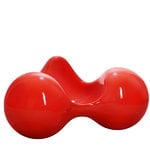At the first sight the Tomato Chair looks complicated, but the second look shows an intelligent combination of three circles with same diameter, two of them being armrests, one stretched to a comfortable back, and even a fourth half circle up side down giving the chair a consequent seat. When looking at the Tomato Chair from different angles it is more than a chair, it is a sculpture.
Tomato chair
Eero Aarnio Originals
Description
At the first sight the Tomato Chair looks complicated, but the second look shows an intelligent combination of three circles with same diameter, two of them being armrests, one stretched to a comfortable back, and even a fourth half circle up side down giving the chair a consequent seat. When looking at the Tomato Chair from different angles it is more than a chair, it is a sculpture.
Product details (5)
- Material
- Fibreglass, Gelcoat finish
- Width
- 141 cm
- Depth
- 114 cm
- Height
- 66 cm
- Weight
- 18 kg
- Product ID
Designer
Eero Aarnio (b. 1932) is a Finnish designer and professor h.c. and is considered one of the great innovators of modern furniture design. During the years, Aarnio has experimented with a variety of different materials, including plastic, fibreglass and foam plastic. With these materials he has created some of the icons of Finnish design such as the Ball Chair (1962), Bubble Chair (1968) and Pastil Chair (1968), just to name a few.
Famous for his furniture, Eero Aarnio is renowned also for his lamps – such as Double Bubble and Swan – and has proven his skills as a wood designer as well – for example with the Rocket bar stool and the Baby Rocket stool are excellent examples of his wooden designs. Eero Aarnio’s designs are characterized by a positive attitude and joyful nature, exemplified in works like the playful Puppy or the lovely Dino.
Aarnio’s creations are present in the collections of numerous museums worldwide – including the Victoria and Albert Hall Museum in London, the MoMA in New York, the Vitra Design Museum in Weil am Rhein, Germany and the Centre Georges Pompidou in Paris – and he has won many prestigious international design awards, such as the Red Dot Design Award and the Compasso d’Oro Design Award.
View all productsReviews (0)
Sustainability
The Product Sustainability Framework, our criteria of sustainable design, helps you find the most sustainable products in our selection. Read below which sustainability criteria this product has met.
Working conditions & labour 9/9
-
Equal opportunities for all employees
-
Commitment to UN Global Compact, fair compensation for all employees
-
Corporate responsibility requirements defined and communicated for suppliers
-
Systematic work for improved inclusion and well-being in the workplace
-
Transparent supply chain
-
Suppliers' compliance to a code of conduct ensured
-
Direct suppliers audited and certified
-
Compliance to the UN Guiding Principles on Business and Human Rights ensured in the supply chain
-
Support for community involvement in the supply chain
Eco-friendly production 9/9
-
Fair and resource-wise water-use in production
-
No incineration or landfilling of returned items
-
No use of endangered species as materials
-
No direct environmental emissions or waste (excl. GHGs) from production
-
The sustainability of direct suppliers' production is addressed and monitored
-
Production and material sourcing that respect biodiversity, animal rights, and natural ecosystems
-
Material-efficient and ecological packaging
-
Positive impact on nature’s well-being through operations that regenerate natural ecosystems
-
No potentially harmful chemicals used in own production
Climate impact 7/8
-
Company's direct greenhouse gas emissions identified and commitment to reduction
-
Product's carbon impact identified and commitment to reduction
-
Guidance on energy- and eco-efficient use of the product
-
Contribution to climate initiatives beyond the brand’s direct operations
-
Low-carbon or compensated transportation
-
Carbon footprint of the product calculated and goals set to reduce it
-
Carbon neutral or carbon negative product
-
100 % renewable energy in own production and operations
Sustainable materials 6/6
-
Sustainable and long-lasting material choices
-
No harmful or hazardous substances
-
Responsible raw material sourcing and production
-
Materials suited for circularity: monomaterials, recyclable finishings, renewable or recycled contents etc.
-
Ecological materials: natural, biodegradable, recyclable or recycled contents
-
Outstanding materials in terms of innovativeness, responsibility, sustainability and circularity: local production or sourcing, 100 % recycled content, C2C-certification etc.
Circular design 5/5
-
High aesthetic quality promoting long-term use of the product
-
Technically durable product design and material choices
-
Design for enduring life-long quality
-
Design and support for product maintenance, repair and upgradability
-
Innovative circular design solutions: circular service system, resale platform, remanufacturing, collection of used products, etc.




